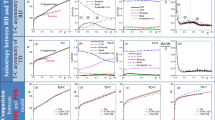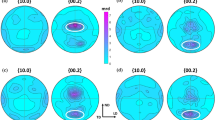Abstract
This paper deals with the characterization and modeling of the deformation behavior of titanium alloy Ti-X© under quasi-static conditions at room temperature. The material investigated is a 1.2 mm thick rolled sheet with a strong basal texture. Monotonic tensile, compressive and cyclic tests in various directions relative to the rolling direction were conducted in order to characterize the material behavior. Textural information was obtained from electron backscatter diffraction (EBSD) data. Strip drawing tests were also carried out. The experimental data has been extended to biaxial stress states using the visco-plastic self-consistent texture model (VPSC). The CPB06ex2 model Plunkett et al. (Int J Plast 24:847–866, 2008) was used to describe the yield surface. This model can describe the anisotropy and the tension-compression asymmetry. Distortional hardening was described taking account of the evolution of the model parameters. An extension of the model using the Armstrong and Frederick approach makes it possible to account for the Bauschinger effect during cyclic loading. There was a high level of correlation between the FE simulation and experimental data.

















Similar content being viewed by others
References
Follansbee PS, Gray GT (1989) An analysis of the low temperature, low and high strain-rate deformation of Ti-6Al-4V. Metall Trans A 20:863–874
Nemat-Nasser S, Guo WG, Cheng JY (1999) Mechanical properties and deformation mechanisms of commercially pure titanium. Acta Mater 47(13):3705–3720
Nemat-Nasser S, Guo WG, Nesterenko VF, Indrakanti SS, Gu Y-B (2001) Dynamic response of conventional and hot isostatically pressed Ti-6Al-4V alloys: experiments and modeling. Mech Mater 33:425–439
Majorell A, Srivatsa S, Picu RC (2002) Mechanical behavior of Ti-6Al-4V at high and moderate temperatures—Part I: experimental results. Mater Sci Eng A326:297–316
Majorell A, Srivatsa S, Picu RC (2002) Mechanical behavior of Ti-6Al-4V at high and moderate temperatures—Part II: constitutive modeling. Mater Sci Eng A326:306–316
Khan AS, Suh YS, Kazmi R (2004) Quasi-static and dynamic loading responses and constitutive modeling of titanium alloys. Int J Plast 20:2233–2248
Khan AS, Kazmi R, Farrokh B, Zupan M (2007) Effect of oxygen content and microstructure on the thermo-mechanical response of three Ti-6Al-4V alloys: experiments and modeling over a wide range of strain-rates and temperatures. Int J Plast 23:1105–1125
Khan AS, Yu S, Liu H (2012) Deformation induced anisotropic responses of Ti-6Al-4V alloy Part II: a strain rate and temperature dependent anisotropic yield criterion. Int J Plast. doi:10.1016/j.ijplas.2012.03.013
Khan AS, Yu S (2012) Deformation induced anisotropic responses of Ti-6Al-4V alloy Part I: experiments. Int J Plast. doi:10.1016/j.ijplas.2012.03.015
Khan AS, Kazmi R, Farrokh B (2007) Multiaxial and non-proportional loading responses, anisotropy and modeling of Ti-6Al-4V titanium alloy over wide ranges of strain rates and temperatures. Int J Plast 23:931–950
Lecomte JS, Philippe MJ, Klimanek P (1997) Plastic deformation of a Ti-6 % Al-4 % V alloy with strong transverse-type crystallographic α-texture at elevated temperatures. Mater Sci Eng A234–236:869–872
Yapici GG, Karaman I, Luo Z-P (2006) Mechanical twinning and texture evolution in severely deformed Ti-6Al-4V at high temperatures. Acta Mater 54:3755–3771
Seshacharyulu T, Medeiros SC, Frazier WG, Prasad YVRK (2000) Hot working of commercial Ti-6Al-4V with an equiaxed α-β microstructure: materials modeling considerations. Mater Sci Eng A284:184–194
Seshacharyulu T, Medeiros SC, Frazier WG, Prasad YVRK (2002) Microstructural mechanisms during hot working of commercial grade Ti-6Al-4V with lamellar starting structure. Mater Sci Eng A325:112–125
Cazacu O, Plunkett B, Barlat F (2006) Orthotropic yield criterion for hexagonal closed packed metals. Int J Plast 22:1171–1194
Meredith CS, Khan AS (2012) Texture evolution and anisotropy in the thermo-mechanical response of UFG Ti processed via equal channel angular pressing. Int J Plast 30–31:202–217
Nixon ME, Cazacu O, Lebensohn RA (2010) Anisotropic response of high-purity α-titanium: experimental characterization and constitutive modeling. Int J Plast 26:516–532
Nixon ME, Lebensohn RA, Cazacu O, Liu C (2010) Experimental and finite-element analysis of the anisotropic response of high-purity alpha-titanium in bending. Acta Mater 58:5759–5767
Cazacu O, Barlat F (2001) Generalization of Drucker’s yield criterion to orthotropy. Math Mech Solids 6:613–630
Cazacu O, Barlat F (2003) Application of the theory of representation to describe yielding of anisotropic aluminum alloys. Int J Eng Sci 41:1367–1385
Cazacu O, Barlat F (2004) A criterion for description of anisotropy and yield differential effects in pressure-insensitive metals. Int J Plast 20:2027–2045
Graff S, Brocks W, Steglich D (2007) Yielding of magnesium: from single crystal to polycrystalline aggregates. Int J Plast 23:1957–1978
Cazacu O, Barlat F (2008) Modeling plastic anisotropy and strength differential effects in metallic materials. In: Cazacu O (ed.), Multiscale Modeling of Heterogeneous Materials: From Microstructure to Macroscale Properties. ISTE Ltd. and John Wiley & Sons, Inc., pp. 71–91
Khan AS, Kazmi R, Pandey A, Stoughton T (2009) Evolution of subsequent yield surfaces and elastic constants with finite plastic deformation. Part I: a very low work hardening aluminum alloy (Al6061-T6511). Int J Plast 25(9):1611–1625. doi:10.1016/j.ijplas.2008.07.003
Plunkett B, Cazacu O, Barlat F (2008) Orthotropic yield criteria for description of the anisotropy in tension and compression of sheet metals. Int J Plast 24:847–866
Plunkett B, Lebensohn RA, Cazacu O, Barlat F (2006) Anisotropic yield function of hexagonal materials taking into account texture development and anisotropic hardening. Acta Mater 54:4159–4169
Lee M-G, Kim D, Kim C, Wenner ML, Wagoner RH, Chung K (2007) A practical two-surface plasticity model and its application to spring-back prediction. Int J Plast 23:1189–1212
Lee JY, Lee JW, Lee M-G, Barlat F (2012) An application of homogeneous anisotropic hardening to springback prediction in pre-strained U-draw/bending. Int J Solids Struct. doi:10.1016/j.ijsolstr.2012.03.042
Armstrong PJ, Frederick CO (1966) A mathematical representation of the multi-axial Bauschinger effect. CEGB report RD/B/N 731, Central Electricity Generating Board. The report is reproduced as a paper: 2007. Mater. High Temperatures, 24:1–26
Choi Y, Han C-S, Lee JK, Wagoner RH (2006) Modeling multi-axial deformation of planar anisotropic elasto-plastic materials, part I: Theory. Int J Plast 22:1745–1764
Choi Y, Han C-S, Lee JK, Wagoner RH (2006) Modeling multi-axial deformation of planar anisotropic elasto-plastic materials, part II: Applications. Int J Plast 22:1765–1783
Lebensohn RA, Tomé CN (1993) A self-consistent anisotropic approach for the simulation of plastic deformation and texture development of polycrystals: application to zirconium alloys. Int J Plast 41(9):2611–2624
Segurado J, Lebensohn RA, LLorca J, Tomé CN (2012) Multiscale modeling of plasticity based on embedding the viscoplastic self-consistent formulation in implicit elements. Int J Plast 28:124–140
Boyer R, Welsch G, Collings EW (1994) Materials Properties Handbook: Titanium Alloys. ASM International, Metals Park
Krasovskyy A (2005) Verbesserte Vorhersage der Rückfederung bei der Blechumformung durch weiterentwickelte Werkstoffmodelle. Dissertation Fakultät für Maschinenbau, KIT Karlsruhe. http://digbib.ubka.uni-karlsruhe.de/volltexte/1000003670urn:nbn:de:swb:90-36703
Han C-S, Chung K, Wagoner RH, Oh S-I (2003) A multiplicative finite elasto-plastic formulation with anisotropic yield functions. Int J Plast 19:197–211
Khan AS, Huang S (1995) Continuum Theory of Plasticity. A Wiley-Interscience Publication. John Wiley & Sons, New York
Wu PD, Jain M, Savoie J, MacEwen SR, Tugcu P, Neale KW (2003) Evaluation of anisotropic yield functions for aluminum sheets. Int J Plast 19:121–138
Chaboche JL, Rousselier G (1983) On the plastic and viscoplastic constitutive equations—Part I. Rules developed with internal variable concept. J Press Vessel Technol 105:153–158
Chichili DR, Ramesh KT, Hemker KJ (1998) The high-strain-rate response of alpha-titanium: experiments, deformation mechanisms and modeling. Acta Mater 46(3):1025–1043
Acknowledgments
The authors wish to thank Dr. Winfried Schmitt and Prof. Dr. Hermann Riedel from Fraunhofer Institute for Mechanics of Materials IWM, Germany for the detailed discussions and helpful comments related to this work.
Author information
Authors and Affiliations
Corresponding author
Rights and permissions
About this article
Cite this article
Tritschler, M., Butz, A., Helm, D. et al. Experimental analysis and modeling of the anisotropic response of titanium alloy Ti-X for quasi-static loading at room temperature. Int J Mater Form 7, 259–273 (2014). https://doi.org/10.1007/s12289-013-1125-z
Received:
Accepted:
Published:
Issue Date:
DOI: https://doi.org/10.1007/s12289-013-1125-z




